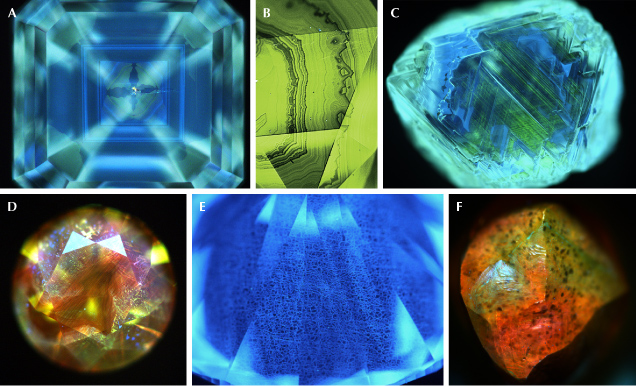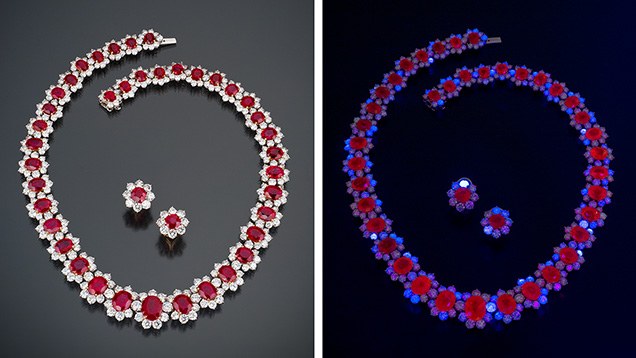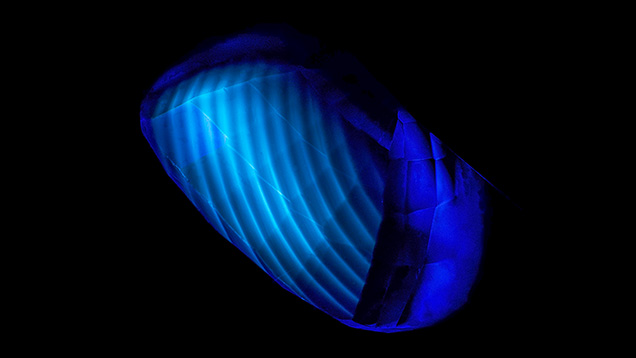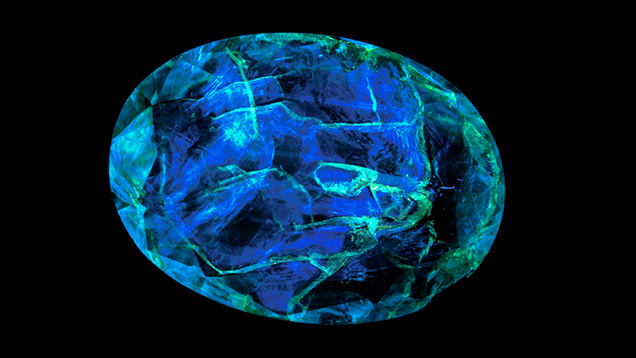G&G in a Flash: Glowing Gems - What Does Fluorescence Tell Us?
May 22, 2025

Why Fluorescence Matters
Fluorescence happens when certain elements and crystal defects inside a gem get “excited” by ultraviolet rays and respond by glowing in vibrant colors, such as blue, green, or even red. It's like a gemstone’s private light show!But fluorescence isn’t just beautiful. For experts, it can be an easy and powerful tool that helps determine gem identity, spot natural vs. laboratory-grown diamonds, uncover treatments like fracture-filling or coatings, and even detect rare hybrid stones.
Retailers can use both long-wave and short-wave UV testing methods—while taking proper precautions to protect their eyes and skin—to gain valuable insights. Although in-store UV equipment isn’t as advanced or diagnostic as the instruments used in professional gemological laboratories, it can still be useful. When combined with other tools and observations, UV testing can help flag stones that may warrant further analysis by a gem lab.
In a market where authenticity and value matter more than ever, being able to interpret a gem’s glow can give retailers a real advantage—safeguarding their reputation and ensuring customers receive exactly what they expect.
Identifying Diamonds Using Fluorescence
Fluorescence & PhosphorescenceScientists can use both fluorescence and phosphorescence to help distinguish natural diamonds from their laboratory-grown counterparts. Natural diamonds that fluoresce (about 30% of natural diamonds) tend to glow brighter than laboratory-grown diamonds under long-wave UV than under short-wave UV light. Laboratory-grown diamonds, on the other hand, tend to glow brighter under short-wave UV than under long-wave UV light.
Phosphorescence—the lingering glow that continues for seconds or even minutes after UV light is turned off—is uncommon in natural diamonds but frequently observed in lab-grown diamonds, particularly those produced using the HPHT (high pressure, high temperature) method. Because phosphorescence is so rare in natural stones, any diamond that exhibits this glow warrants further analysis to determine its origin. While not conclusive on its own, phosphorescence is an important clue among many that can help identify a diamond’s true nature.
Fluorescence Pattern
In addition to short-wave and long-wave UV, scientists also use deep-UV fluorescence to distinguish between natural and laboratory-grown diamonds. Deep-UV excitation is typically only performed in laboratories, since this wavelength can damage eyes and skin. It should be done with the diamond and the fluorescence source inside an enclosed chamber and with a digital camera showing the detected fluorescence on a computer. These safety precautions and specialized equipment make deep-UV fluorescence a much more expensive method of analysis than long-wave and short-wave fluorescence.Under deep-UV light, natural diamonds typically exhibit growth patterns that appear square or rectangular, while HPHT-grown diamonds often show cuboctahedral patterns—a clear visual difference.
Beyond shape, natural diamonds possess intricate internal growth structures that reflect their long and complex geological history. Over time, these diamonds undergo changes in fluid composition and exposure to aggressive fluids that can dissolve or resorb parts of the crystal. They may also experience intense pressure that causes crystal deformation, introducing defects like dislocations and glide planes.
These environmental stresses create a unique "fingerprint" within each natural diamond that is only visible under deep-UV light. Much like the growth rings of a tree, these patterns tell a story of formation, transformation, and survival through Earth’s dynamic processes. In contrast, laboratory-grown diamonds lack this complexity, resulting in simpler, more uniform fluorescence patterns.
Hybrid Natural and Laboratory-Grown Diamonds
Deep-UV imaging has become an invaluable tool for detecting rare CVD hybrids—diamonds that combine natural and lab-grown components. These stones are created by growing CVD (Chemical Vapor Deposition) diamond layers directly onto natural diamond substrates, either to increase the overall weight of the diamond or to enhance color, such as producing blue hues through type IIb CVD overgrowth.
Under deep-UV light, the two parts of the hybrid reveal their origins: the natural diamond regions typically fluoresce blue, while the CVD-grown layers often fluoresce red. This striking contrast helps gemologists identify these sophisticated hybrids, which can be challenging to detect through standard testing methods.
Learn more about diamond fluorescence and whether you want it in your diamond!

Identifying Rubies Using Fluorescence
Distinguishing Natural from Laboratory-Grown Rubies
Fluorescence is a valuable tool for distinguishing between natural and synthetic rubies, as well as for detecting heat treatment in some rubies and sapphires. Under both long-wave and short-wave UV, lab-grown rubies often fluoresce more strongly than natural ones because they typically contain little to no iron—an element that suppresses fluorescence. However, some natural rubies, especially those from low-iron marble deposits like those in Myanmar, can exhibit similarly strong fluorescence. For this reason, fluorescence testing must be used in combination with other methods to accurately determine a ruby’s origin.
Short-wave and deep-UV light can also reveal growth structures within corundum (the mineral family that includes ruby and sapphire). For instance, curved growth banding—enhanced under UV light—is a hallmark of flame-fusion synthetic sapphires, while natural stones display more angular, hexagonal growth patterns.
Identifying Heat Treatment
Fluorescence can also be a useful clue when it comes to spotting heat treatment. Many low-iron sapphires and rubies that have been low-temperature heat-treated will glow chalky blue under short-wave UV light. Spotting this isn’t always easy, however; some rubies also give off a red fluorescence that can mask this chalky blue glow. Also, some lab-grown rubies and sapphires display chalky blue fluorescence as well. Finally, if a stone doesn’t fluoresce, that doesn’t necessarily mean it’s unheated. Fluorescence bands can be erased by high temperature heat treatment, especially those above about 1500°C.

Identifying Fracture-Filling, Coating & Dyeing Using Fluorescence
Corundum, Emeralds, Jadeite & Pearls
While UV fluorescence is more commonly associated with diamonds, it can also be a potent tool for detecting treatments in colored stones like corundum (ruby and sapphire), emerald, and jade. Coatings, dyes, and fracture-filling materials often fluoresce differently than the host gem, helping to reveal their presence. Deep-UV light can also offer clues about the type of filler used and the extent of clarity enhancement. For example, glass fillers used in surface-reaching fractures in rubies may fluoresce blue—standing out clearly against the ruby’s natural red fluorescence. Using a blue band-pass filter can suppress the red background glow, making the filler’s fluorescence easier to spot.
A similar technique can be applied to clarity-enhanced emeralds. Epoxy resins and oils used as fillers fluoresce in distinctive colors, offering hints about the material used.
In jadeite, which is typically inert under UV light, fluorescence testing can help detect treatments such as coating, dyeing, and impregnation. Waxes and epoxy resins used to impregnate jadeite often fluoresce blue under long-wave UV, with epoxy resins sometimes showing a weblike fluorescence pattern—especially under deep-UV excitation. Coated jadeite may also reveal a contrast in fluorescence color and intensity between the coating and any exposed natural jade.
Fluorescence can also be useful when evaluating pearls. A strong bluish glow under long-wave UV may suggest the use of optical brighteners—treatments designed to mask less desirable yellow tones by enhancing blue fluorescence. However, this observation alone isn’t conclusive and must be evaluated alongside other diagnostic tests.

Conclusion
Fluorescence and phosphorescence are powerful analytical tools that reveal important details about a gemstone’s history—whether it's natural, laboratory-grown, treated, or altered through post-growth processes. These luminescent effects arise from structural defects and trace impurities within the crystal lattice, detectable even at concentrations as low as a few parts per billion. Thanks to its simplicity, affordability, and easily interpretable results, luminescence testing is an invaluable technique for gemologists and professionals throughout the trade.
Looking for a quick, easy way to distinguish natural, untreated diamonds from laboratory-grown or treated ones? Discover the GIA iD100®
.jpg)


